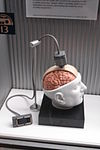- Neurohacking
-
Neurohacking is the colloquial term for (usually personal or 'DIY') neuroengineering. It is a form of biohacking (qv) focusing on the brain and CNS. Strictly speaking it is any method of manipulating or interfering with the structure and/or function of neurons for improvement or repair.
Contents
Reasons
Mental health
The main goal of neurohacking is optimal mental health. Other goals include damage repair, simulated reality, prevention of disease and augmentation of abilities or of intelligence overall. It utilises information and technology mainly from the fields of epigenetics, bio/neurofeedback, psychopharmacology, biological psychology and functional analysis, but many practitioners also employ physical exercise, nutritional guidelines, vitamins & supplements, meditation and/or self-hypnosis. Some avoid all neuroactive substances including caffeine, alcohol, food additives and fast-release sugars. Current research focuses on the nature and development of intelligence and how to increase or improve it. The works of Dr. Herman Epstein, Joseph LeDoux, Alex Ramonsky and David Barker are influential. The ethical basis of Neurohacking for health is that it should be practiced strictly with informed consent.
Information retrieval
The term neurohacking is also used for a method of attempting to retrieve information from the brain (such as passwords, locations, etc..) without consent; presently no technology exists for such a tactic. The concept has been used in much science fiction (e.g. the film "The Matrix"). In data retrieval, some sort of brain–computer interface (BCI) is typically used, where the brains neuron synapses are somehow captured or recorded to be processed for information. Promoters of this concept generally refer to the MRI (magnetic resonance imaging) or MEG (magnetoencephalography) to support the plausibility of this concept. Although some sort of neuroimaging could someday be used, the accuracy of any present day method is not nearly close enough. For instance, it is assumed that neurohacking requires detection of the state of individual neurons (approximately 1 micrometer diameter) while the resolution of the MEG is several thousand neurons and other imaging systems may be even larger. It is estimated that usable neurohacking of this type is still many decades away.
Notes
See also
- Biohacker
- Simulated reality
- Transhumanism
External links
- The Neurohackers Association
- I've Changed My Mind by Alex Ramonsky
- Cyberware Technology by Taryn East
- Wetware Technology
Brain–computer interface Technologies Biomechatronics · Brain implant · BrainGate · Brainport · Cyberware · Exocortex · Intelligence amplification · Isolated brain · Neuroprosthetics · Neurotechnology · Optogenetics · Sensory substitution · Synthetic telepathy
Scientific phenomena Disciplines Speculative People Charles Stross · Douglas Engelbart · Hugh Herr · J. C. R. Licklider · Kevin Warwick · Matt Nagle · Merlin Donald · Miguel Nicolelis · Peter Kyberd · Steve Mann · Vernor Vinge · Yoky Matsuoka · Edward BoydenOther  Category ·
Category ·  Commons
Commons
This nanotechnology-related article is a stub. You can help Wikipedia by expanding it.
